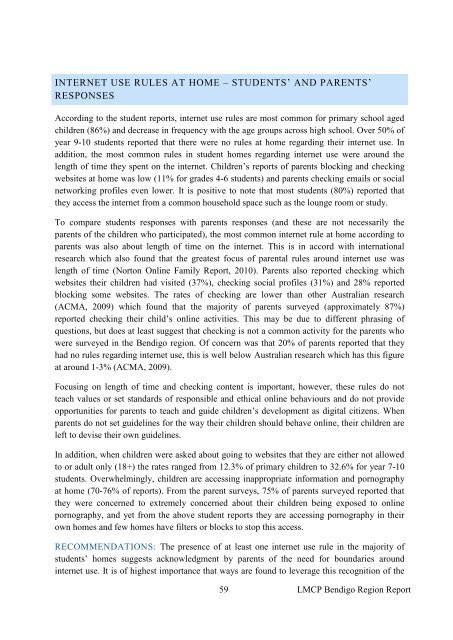LODDON MALLEE - Cyber Safe Kids
LODDON MALLEE - Cyber Safe Kids
LODDON MALLEE - Cyber Safe Kids
You also want an ePaper? Increase the reach of your titles
YUMPU automatically turns print PDFs into web optimized ePapers that Google loves.
INTERNET USE RULES AT HOME – STUDENTS‟ AND PARENTS‟<br />
RESPONSES<br />
According to the student reports, internet use rules are most common for primary school aged<br />
children (86%) and decrease in frequency with the age groups across high school. Over 50% of<br />
year 9-10 students reported that there were no rules at home regarding their internet use. In<br />
addition, the most common rules in student homes regarding internet use were around the<br />
length of time they spent on the internet. Children‟s reports of parents blocking and checking<br />
websites at home was low (11% for grades 4-6 students) and parents checking emails or social<br />
networking profiles even lower. It is positive to note that most students (80%) reported that<br />
they access the internet from a common household space such as the lounge room or study.<br />
To compare students responses with parents responses (and these are not necessarily the<br />
parents of the children who participated), the most common internet rule at home according to<br />
parents was also about length of time on the internet. This is in accord with international<br />
research which also found that the greatest focus of parental rules around internet use was<br />
length of time (Norton Online Family Report, 2010). Parents also reported checking which<br />
websites their children had visited (37%), checking social profiles (31%) and 28% reported<br />
blocking some websites. The rates of checking are lower than other Australian research<br />
(ACMA, 2009) which found that the majority of parents surveyed (approximately 87%)<br />
reported checking their child‟s online activities. This may be due to different phrasing of<br />
questions, but does at least suggest that checking is not a common activity for the parents who<br />
were surveyed in the Bendigo region. Of concern was that 20% of parents reported that they<br />
had no rules regarding internet use, this is well below Australian research which has this figure<br />
at around 1-3% (ACMA, 2009).<br />
Focusing on length of time and checking content is important, however, these rules do not<br />
teach values or set standards of responsible and ethical online behaviours and do not provide<br />
opportunities for parents to teach and guide children‟s development as digital citizens. When<br />
parents do not set guidelines for the way their children should behave online, their children are<br />
left to devise their own guidelines.<br />
In addition, when children were asked about going to websites that they are either not allowed<br />
to or adult only (18+) the rates ranged from 12.3% of primary children to 32.6% for year 7-10<br />
students. Overwhelmingly, children are accessing inappropriate information and pornography<br />
at home (70-76% of reports). From the parent surveys, 75% of parents surveyed reported that<br />
they were concerned to extremely concerned about their children being exposed to online<br />
pornography, and yet from the above student reports they are accessing pornography in their<br />
own homes and few homes have filters or blocks to stop this access.<br />
RECOMMENDATIONS: The presence of at least one internet use rule in the majority of<br />
students‟ homes suggests acknowledgment by parents of the need for boundaries around<br />
internet use. It is of highest importance that ways are found to leverage this recognition of the<br />
59 LMCP Bendigo Region Report


